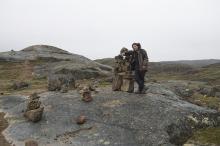Update
Learn more about the research directly through the research team and Mark Goldner! Check out one of two PolarConnect events by visiting the PolarConnect Archives..
What Are They Doing?
The Svalbard Archipelago has an arctic climate and is home to several large bodies of ice called glaciers. There are alpine glaciers in the mountains, and also tidewater glaciers that end in long narrow bodies of seawater called fjords. For the past nearly 10,000 years, the glaciers of this region have been receding and most recently there has been a regional reduction in sea ice. The region is ideal for the study of past climate because the arctic is sensitive to changes in climate and several different types of measurements on and around glaciers can be conducted here.
The research team, which included undergraduate geoscience students participating in the Research Experiences for Undergraduates Program, traveled to Svalbard to investigate how climate change affects sediment transport and deposition associated with the tidewater glaciers, icebergs, meltwater streams, and marine currents. Tidewater glaciers are among the fastest changing systems in the Arctic, offering the team the opportunity to monitor rapidly changing and dynamic systems.
To conduct their research, they sampled ice from Svalbard glaciers and icebergs and studied the concentration of rocks and sediments. They also studied the sediments on the glacial fjord sea bed to look at where sediment from the glacier was being transported and deposited in the past. The oceanography of the fjord waters in front of the ice margins were also studied by the students. The team also utilized aerial photographs and GPS mapping to determine the position of the glacier and its rate of retreat. Using this data and more, the team helped determine what relationships exist between current sedimentation, glaciers, oceans, and weather data. Being better able to predict how glacial systems react to climate change helps scientists better understand their contribution to sea level rise.
Where Are They?
The team worked on and around Kongsfjord and its glaciers while working out of Ny Alesund on western Spitsbergen, the largest island in the Svalbard island archipelago. The Svalbard archipelago is situated in the Arctic Ocean, north of mainland Europe, approximately mid-way between Norway and the North Pole. Ny Alesund is one of the world’s northernmost settlements and can have a population of up to 120 people during the summer when research is being conducted.
Latest Journals

Ross Powell has been a professor in the Department of Geology and Environmental Sciences at Northern Illinois University since the early 1980's. His main research interests focus on processes where glaciers and ice sheets enter the sea, and his recent research has focused on Alaskan and Antarctic glacimarine processes and paleoclimate history involving underwater remotely-operated vehicles (ROV's) among other scientific tools. He has played a lead role in the ANDRILL (Antarctic geological Drilling) Program and the WISSARD program, collecting sediment cores for the first time from a subglacial lake in Antarctica—Lake Whillans. He has mentored teachers in polar field research through the Cape Roberts and ANDRILL programs in Antarctica and the Svalbard REU program in the Arctic. He is also periodically a guest lecturer at the University Center (UNIS) on Svalbard.

Dr. Brigham-Grette's research interests are focused on the stratigraphy, sedimentology, and chronology of geologic systems that record the climate evolution and sea level history of the Arctic since the Pliocene. Most of her research program is aimed at documenting the global context of paleoenvironmental change across "Beringia", i.e., the Bering Land Bridge, stretching across the western Arctic from Alaska and the Yukon into NE Russia including the adjacent marginal seas. Starting in the 1980s with fieldwork on the sea level history and glacial stratigraphy of vast Arctic coastal plains and coastal environments in comparison with regional alpine glaciation, she is now focused on the integration of records from marine and lake systems.
Since 1991, her group has participated in numerous field expeditions to remote regions of Arctic Russia and she was co-chief scientist in 2002 of an expedition on the U.S. Coast Guard icebreaker Healy, taking sediment cores from the Bering and Chukchi Seas. She is the US Chief Scientist of the El'gygytgyn Lake Scientific Drilling project, a multinational field program leading to the first unprecedented recovery in 2009 of a 3.6 Myr record of terrestrial paleoclimate. She has previously been involved in the IPY STEM Polar Connections project to integrate the study of polar regions and International Polar Year activities into the middle and high school curriculum from the terrestrial Arctic.





